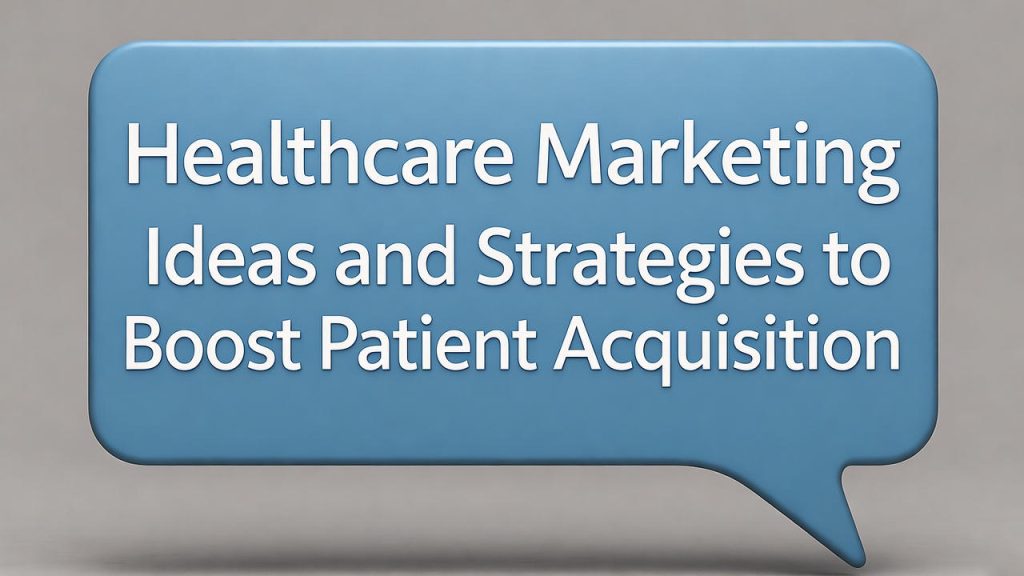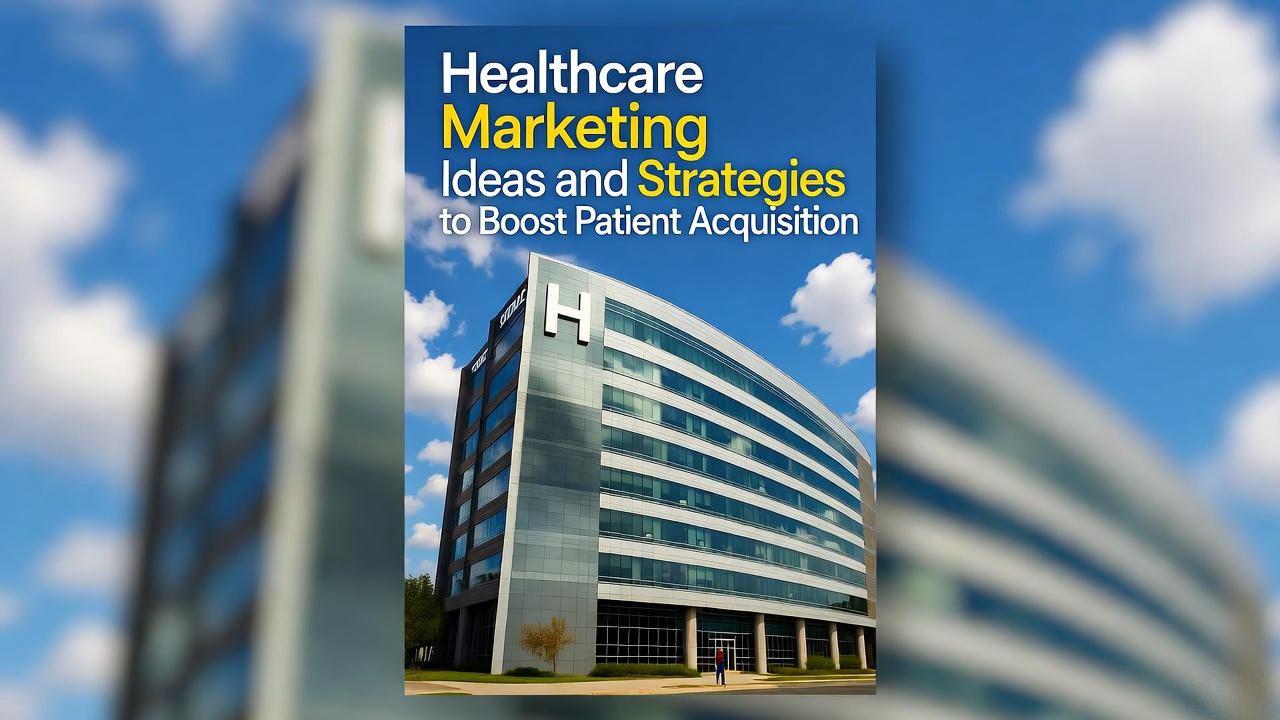
In today’s competitive healthcare landscape, attracting and retaining patients is more challenging than ever. Hospitals, clinics, and private practices across the US, UK, Canada, and Australia are constantly seeking innovative ways to stand out. Patients have higher expectations—they want transparency, trust, convenience, and personalized experiences. This is where strategic healthcare marketing becomes critical. A health care marketing agency can provide expertise in designing campaigns that resonate with diverse demographics, while healthcare marketing ideas such as patient education, social media engagement, and localized SEO can directly boost patient acquisition.
Consider a mid-sized clinic in Toronto that struggled to fill appointment slots. By leveraging targeted Facebook campaigns, Google Local Service Ads, and educational blog content, the clinic saw a 45% increase in new patient bookings within three months. The power of healthcare marketing lies in understanding patient behavior, identifying communication channels, and creating compelling messaging. Whether it’s email campaigns for follow-ups, video content for educating patients, or referral programs incentivizing loyalty, every touchpoint can be optimized to increase engagement and conversion.
Healthcare marketing companies are increasingly using analytics-driven approaches to track patient acquisition costs, campaign ROI, and engagement rates. The goal is not just to attract patients, but to cultivate long-term trust and loyalty. By combining traditional marketing methods with digital strategies—SEO, social media, online reviews, and telehealth promotion—healthcare providers can achieve measurable growth in patient volume and revenue.
Healthcare marketing is not an expense; it’s an investment in your clinic’s growth. Explore more details here → Implementing structured marketing strategies tailored for Tier One markets ensures your healthcare practice thrives amid competition and patient expectations.
10 Healthcare Marketing Ideas and Strategies to Increase Patient Engagement in Tier One Countries
Engaging patients is at the core of healthcare marketing. Tier One markets like the US, UK, Canada, and Australia offer unique opportunities because patients actively research and compare healthcare providers online before booking appointments. One proven strategy is personalized content marketing. Clinics that publish condition-specific blogs, treatment guides, or success stories help patients feel informed and reassured. For instance, a Melbourne-based dermatology clinic increased patient inquiries by 60% after launching a weekly skin health video series.
Another critical approach is multichannel outreach. Patients interact with providers via emails, social media, and SMS reminders. According to a US study, SMS appointment reminders reduce no-show rates by 30%. Healthcare marketing companies recommend integrating automated reminders with educational snippets to improve adherence and satisfaction. Telehealth promotion is also vital in post-COVID Canada and Australia. Clinics offering virtual consultations can market convenience and safety, boosting patient acquisition.
Top 5 Engagement Strategies in Tier One Healthcare Markets
| Personalized Content | Blogs, video guides | 40–60% higher inquiries |
| Social Media | Facebook & Instagram ads | Increased engagement & brand awareness |
| Email & SMS Campaigns | Appointment reminders & tips | Reduce no-shows 20–30% |
| Telehealth Services | Virtual consultations | Attracts remote patients |
| Patient Feedback Systems | Online reviews & surveys | Builds trust & retention |
Key Tip: Micro-target patients by age, location, and condition for better ROI.
Explore healthcare marketing agency packages tailored for US & UK clinics →
Types of Marketing in Healthcare: Choosing the Right Channels for Maximum ROI
Healthcare marketing spans digital, traditional, and referral channels, each with unique ROI potential. Digital marketing includes SEO, social media, email campaigns, and paid ads. Traditional marketing involves print materials, billboards, and local events. Referral channels include physician networks, patient testimonials, and partnerships with wellness centers.
A case study from Chicago illustrates channel optimization. A cardiology clinic used Google Ads for condition-specific searches, Facebook for local awareness, and referral incentives to physicians. Over six months, they achieved a 70% growth in new patients. ROI was highest from targeted digital ads, proving that online channels are increasingly essential.
Channel Comparison for Healthcare Marketing ROI
| SEO | Medium | High | High | Very High |
| Social Media | Medium | High | Medium | High |
| Paid Ads | High | Medium | High | High |
| Print Ads | Medium | Low | Low | Medium |
| Referral Programs | Low | Medium | High | Very High |
Diversify channels, but prioritize digital for measurable results.
Contact a healthcare marketing agency for multi-channel strategies →
Why Is Healthcare Marketing Important for Hospitals, Clinics, and Medical Practices?
Healthcare marketing is essential because it directly impacts patient volume, revenue, and brand reputation. Hospitals in competitive cities like New York and London rely on marketing to highlight specialty services, showcase physician expertise, and share patient success stories. Without marketing, even excellent medical services remain underutilized.
For example, a private clinic in Vancouver increased revenue by 35% in one year after launching a comprehensive marketing campaign that included social media, Google Ads, and patient newsletters. Marketing also helps in education and compliance, guiding patients about preventive care, vaccination programs, and chronic disease management.
Highlight patient-centric stories to build trust and emotional connection.
Explore healthcare marketing strategies designed for clinics in Australia →
Benefits of Healthcare Marketing: Drive Revenue and Patient Retention in the US & UK
Investing in healthcare marketing brings measurable benefits: increased patient acquisition, higher retention, stronger brand recognition, and improved patient experience. Retaining existing patients is more cost-effective than acquiring new ones, yet marketing is often overlooked in this area. A London-based orthopedic practice saw a 25% increase in returning patients by sending personalized post-visit emails and health tips.
Marketing campaigns also enhance visibility on Google and social media, positioning practices as experts in their fields. SEO for healthcare providers ensures that patients searching for treatments find your clinic first.
Benefits of Healthcare Marketing
| Patient Acquisition | Google Ads, local SEO | 40–50% new patient growth |
| Patient Retention | Email campaigns | 20–30% returning patients |
| Brand Recognition | Social media & PR | Increased trust & referrals |
| Revenue Growth | Multi-channel marketing | 30–40% revenue boost |
Healthcare marketing transforms patient relationships into a long-term business strategy.
Get a free assessment of your US or UK clinic marketing →
Digital Marketing in Healthcare: Best Practices for Canadian & Australian Markets
Digital marketing in healthcare focuses on SEO, paid search, social media, email, and online reputation management. Canadian and Australian patients heavily research providers online. Ensuring your clinic ranks for local searches like “family doctor near me” or “best dermatologist Sydney” is critical.
A micro-case study: A Toronto pediatric clinic optimized its website for local keywords, used Facebook Ads targeting parents, and encouraged Google reviews. Result: 55% increase in online appointment requests in 4 months. Social media campaigns should combine education and engagement; video content about treatments can humanize healthcare brands.
Leverage structured data (schema markup) for local SEO and improved click-through rates.
Learn how a healthcare marketing agency can boost Canadian patient bookings →
Table
How to Create a Healthcare Marketing Strategy: Step-by-Step Guide for High ROI
Start by defining objectives: patient acquisition, retention, or brand awareness. Next, analyze your target audience’s demographics, behavior, and preferred channels. Develop messaging aligned with patient concerns.
Pros and Cons Table: Marketing Strategy Approaches
| Content Marketing | Builds trust & SEO | Requires time & resources |
| Paid Ads | Immediate traffic & leads | Higher costs |
| Social Media | Engagement & brand awareness | Algorithm dependency |
| Referral Programs | Cost-effective | Limited reach |
Dr. Susan Lee, US healthcare strategist: “Data-driven campaigns outperform generic ads. Use analytics to optimize every patient touchpoint.”
What Is Healthcare Marketing? Understanding Its Role in Modern Medical Practices
Healthcare marketing is the practice of promoting medical services and building patient relationships. It blends traditional PR with digital strategies to influence patient decisions. Its role is growing due to increased patient choice, telehealth adoption, and competition among providers. Marketing helps communicate value, educate patients, and drive appointments efficiently.
Steps to Building Your Healthcare Marketing Strategy That Converts Patients Online
- Audit current marketing efforts.
- Define patient personas and pain points.
- Select optimal channels: social media, SEO, paid ads, and email.
- Create content that educates, informs, and engages.
- Track KPIs: CTR, patient inquiries, conversion rate.
Focus on high-intent keywords and localized campaigns for Tier One markets.
10 Healthcare Marketing Strategies to Grow Your Healthcare Organization in Tier One Markets
- Local SEO & Google Business Profile optimization
- Social media patient education
- Email & SMS reminders
- Video marketing & webinars
- Influencer partnerships with health bloggers
- Paid search & display ads
- Telehealth promotion
- Referral & loyalty programs
- Reputation management & patient reviews
- Analytics-driven iterative campaigns
Explore comprehensive marketing packages for the US, UK, Canada & Australia →
SEO for Healthcare Providers: Boost Visibility & Appointment Bookings
Optimizing websites for search engines and local intent improves visibility. Key steps include keyword research, meta optimization, local citations, backlinks, and mobile-friendly design. Studies show that clinics ranking in the top 3 Google results receive ~65% of clicks.
Social Media Marketing for Healthcare: Engage Patients and Build Trust
Platforms like Facebook, Instagram, and LinkedIn can humanize your practice, share patient stories, and deliver health tips. Engaging posts build trust, encourage shares, and increase referrals.
Patient-centric storytelling increases engagement by 70% compared to generic promotional posts.
Key Takeaways Recap:
- Tailor marketing for Tier One audiences.
- Digital channels offer measurable ROI.
- Content & social media build trust and patient loyalty.
- SEO and local listings drive appointments.
- Data-driven strategies maximize efficiency.
FAQ
Q1: What is healthcare marketing, and why is it essential?
Healthcare marketing promotes medical services, educates patients, and builds trust. It is essential for hospitals, clinics, and private practices to attract new patients, retain existing ones, and establish authority in competitive markets like the US, UK, Canada, and Australia. Proper marketing ensures visibility, increases patient engagement, and drives measurable revenue growth.
Q2: How can a healthcare marketing agency help my clinic?
A healthcare marketing agency offers expertise in strategy, SEO, social media, paid campaigns, and analytics. They optimize patient acquisition costs, manage multi-channel campaigns, and ensure compliance with healthcare regulations. Clinics benefit from data-driven marketing that maximizes ROI while enhancing patient trust and retention.
Q3: What are the most effective healthcare marketing strategies in Tier One markets?
Top strategies include local SEO, content marketing, social media engagement, email/SMS campaigns, telehealth promotion, referral programs, and online reputation management. Using a mix of digital and traditional channels helps clinics in the US, UK, Canada, and Australia attract and retain patients efficiently.
Q4: How can SEO improve patient bookings for healthcare providers?
SEO improves online visibility when patients search for medical services. Optimized websites, local keywords, Google Business profiles, and backlinks help clinics rank higher in search results. Higher visibility leads to more inquiries, appointment bookings, and increased patient trust.
Q5: What is the ROI of healthcare marketing for hospitals and clinics?
ROI varies based on strategy, but studies indicate digital marketing can boost patient acquisition by 30–70% and retention by 20–40%. Efficient campaigns reduce no-shows, enhance patient lifetime value, and improve overall revenue. Long-term, marketing ensures sustainable growth and competitive advantage.





